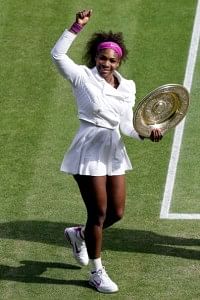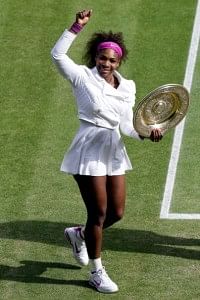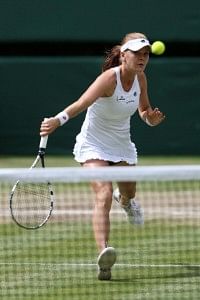
Serena Williams: Bullying her way to immortality
 For a while out there on Centre Court, it looked like a hulking bully was trampling all over a tiny, reed-like nerd. The kind of scene they show in the movies, you know? The one where the small-statured hero suffers abuse and oppression at the hands of the unruly bully? In the movies, the bully invariably meets a humiliating, sorry fate; the nerd always finds a way to turn things around and upstage his stronger adversary in the end. That’s how it should be, right? Brains triumphing over brawn? Unfortunately for the members of the WTA, Serena Williams, the quintessential bully of women’s tennis, never got that memo. And judging from the way she mercilessly blasts the tennis ball on the court, she obviously doesn’t watch the kind of movies that we ordinary mortals do, either.
For a while out there on Centre Court, it looked like a hulking bully was trampling all over a tiny, reed-like nerd. The kind of scene they show in the movies, you know? The one where the small-statured hero suffers abuse and oppression at the hands of the unruly bully? In the movies, the bully invariably meets a humiliating, sorry fate; the nerd always finds a way to turn things around and upstage his stronger adversary in the end. That’s how it should be, right? Brains triumphing over brawn? Unfortunately for the members of the WTA, Serena Williams, the quintessential bully of women’s tennis, never got that memo. And judging from the way she mercilessly blasts the tennis ball on the court, she obviously doesn’t watch the kind of movies that we ordinary mortals do, either.
In the women’s final at Wimbledon today, Serena Williams held a huge size and power advantage over the diminutive Agnieszka Radwanska, and for two out of the three sets, she exploited that advantage to the fullest. She served hard and pounded her groundstrokes, and she never seemed in danger of being outsmarted by her crafty opponent. That she actually lost a set mid-way through the match was down as much to her own profligacy as it was to some fine play from Radwanska. The match, as the cliche goes, was on Serena’s racquet, and the American used that racquet to bludgeon her way to a 5th Wimbledon title and 14th Major overall.
There are many things that Radwanska does better than the rest of the women’s tour. She uses the full depth of the court, and finds the most impossible of angles to put the ball away from the opponent. Her clever variations (her dropshots and lobs are particularly eye-catching) and her soft hands give the impression that she caresses the ball rather than hit it. On most days, those combinations are enough to completely befuddle the player on the other side of the net. But Radwanska is no Justine Henin; she plays an intelligent game, but lacks the power and oomph that could have turned that intelligent game into a consistently lethal one. And as it turned out, that lack of power proved to be her undoing in her first-ever Slam final. While she hit her spots with her serve, she simply lacked the pace to trouble Serena; the American only had to take a step in either direction and smack the return hard and flat into the corners. Radwanska’s groundstrokes suffered similarly; she kept finding the right angles with her shots, but the lack of juice on them meant Serena always had time to get in position and take back the initiative in the rally. Like the schoolyard scene again, Radwanska kept putting together meticulously-structured edifices, and Serena kept destroying them with her power-packed punches.
 And yet, despite all the inherent disadvantages Radwanska has when pitted against a player like Serena, she still had a very real chance of pulling the rug from under Serena’s feet. After being blown away in a 6-1 first set and going down a break in the second, Radwanska suddenly found her first, and only, sustained patch of brilliantly beguiling tennis. Just as importantly, her purple patch coincided with a somewhat expected, but still disturbing, dip in Serena’s level. The American’s groundstrokes abandoned her, and she managed to stay in the set for as long as she did merely on the strength of her supersonic serve. But at 5-6, that killer weapon deserted her too, and Radwanska was only too happy to pocket the set and canter to a third.
And yet, despite all the inherent disadvantages Radwanska has when pitted against a player like Serena, she still had a very real chance of pulling the rug from under Serena’s feet. After being blown away in a 6-1 first set and going down a break in the second, Radwanska suddenly found her first, and only, sustained patch of brilliantly beguiling tennis. Just as importantly, her purple patch coincided with a somewhat expected, but still disturbing, dip in Serena’s level. The American’s groundstrokes abandoned her, and she managed to stay in the set for as long as she did merely on the strength of her supersonic serve. But at 5-6, that killer weapon deserted her too, and Radwanska was only too happy to pocket the set and canter to a third.
Memories of her shock loss to Virginie Razzano in the French Open first round last month came flooding back. She couldn’t seem to find the court any more, and Radwanska was taking full advantage of her opponent’s free-flowing errors. But then came the moment that defines Serena the player. Serving at 1-2 in the third, and seemingly straining under the effort of keeping her dogged opponent at bay, she lined up to serve in her typically slow, deliberate motion. First point: ace. Second point: ace. Third point: ace. Fourth point: ace. 49 seconds in, the game was done and dusted, and Radwanska was serving again. It was a statement of intent from Serena; she used her signature shot – her serve – to announce that she wasn’t about to fold just yet. Radwanska never had a chance after that, and indeed, she proceeded to lose 5 consecutive games to hand Serena the match and the championship.
With 5 titles at the All-England Club, Serena now has just as much right to the title of ‘Queen of Grass’ as does fellow 5-time champion Venus. But this win goes beyond the numbers. Serena hadn’t won a Slam in 2 years (the last one she had won was her overwhelmingly dominant victory right here, back in 2010), and her dismal performances in the first two Slams of 2012 had many people questioning her motivation; there were even some calls for retirement. As always, Serena answered her critics the only way she knows how to: with an obliterate-everything-in-the-path title run.
Sure, this wasn’t as smooth a campaign as some of her earlier victory rampages. But Serena made all the right noises at all the right times: against the big guns – Petra Kvitova in the quarters and Victoria Azarenka in the semis – she brought out her best tennis and doused the most cussed efforts of her incredibly talented and determined opponents. Against the lower-ranked players – Zheng Jie in the 3rd round and Yaroslava Shvedova in the 4th – she overcame her customary mid-tournament jitters and made sure she came out the winner. And against all players – high-ranked or low – she served with authority, racking up a tournament-record 102 aces. Serena may not have had the most one-sided run at this year’s Wimbledon, but from a macroscopic point of view, she hardly put a foot wrong all tournament.
The question that begs to be asked, of course, is this: why are we surprised? In the ever-changing circus that is the WTA, one thing has remained constant for the last 10 years: when Serena Williams sets her mind to her tennis, there’s no player in the world that can stop her. The good thing is that Serena doesn’t mind looking like a bully while she goes about her business of winning. If she did, we might have got a more lovable player, but we would almost certainly have lost an indefatigable champion.
Sometimes, the bully can be the hero too.